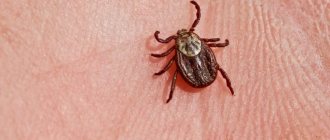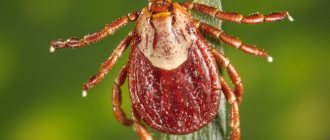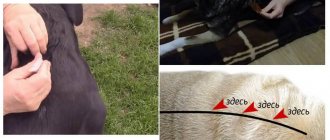Fighting methods
Ixodid ticks not only bite painfully and leave behind inflamed blisters, but they are also carriers of dangerous diseases, including tick-borne encephalitis and borreliosis. It is recommended that everyone avoid meeting them. In the absence of an epidemic or threat of infection, safe methods of control are used - they mow the grass on the site in a timely manner, do not allow overgrowth, trim the branches of bushes, the crowns of young trees to a height of more than 50 cm from the ground. Create unfavorable development conditions for pests.
However, it is not always possible to ensure “sterility” at a summer cottage. Ticks can get into the yard with pets, stray cats, dogs, and rodents. The situation is especially dangerous if there is a forest or city park nearby. The fight against ticks is carried out in several ways - by acting directly on them or on animals that spread parasites throughout the land.
On a note!
It is recommended to fence the area with a fence to prevent the appearance of wild animals, stray dogs and cats. Use rodent traps or periodically place poisonous bait.
The most effective method of control is to treat the area against ticks with poison - insectoacaricidal preparations. The destruction of blood-sucking parasites in open areas occurs within three days, and for about another 2 months the drugs protect the area from re-infection. Anti-tick chemicals are produced in the form of a concentrated emulsion, solution, powder, or checkers.
Protection against ticks using folk remedies involves the use of certain plants and products with a strong, persistent odor. The methods are more aimed at preventing infection than at control, and can be combined with other methods of exterminating pests.
How to recognize a tick
How do you know that a tick has settled in your summer cottage? There is a simple and effective way - in the morning, after the dew has disappeared, run a waffle towel over the bushes and grass. Ticks (if there are any) will definitely move onto the towel. Slowly walk around the entire area in this way, then check the towel for ticks - they can be seen with the naked eye.
This method can be made more effective by blotting off the sweat with a towel first.
Types of ticks
The most common species in Russia can be easily distinguished from each other:
- Ixodid tick. The most frequent guest at the dacha is this particular type of tick. It is also often called encephalitic due to its role as a carrier of the disease. The activity of the ixodid tick occurs in the warm period from mid-May to the end of July, but sometimes the tick also manifests itself at the end of August. It gets on human skin from grass or bushes. It is easy to notice on the skin with the naked eye due to its dark two-color color - the ixodid tick is black-brown and black-red. Its subspecies - the brown dog tick - usually affects four-legged pets, but it remains dangerous for humans.
The ixodid tick is the most common species dangerous to humans. - Argas mite. Unlike the ixodid species, the argasid hunts all year round, but it is much less common in dachas. This species is very dangerous - it carries diseases such as relapsing fever, arbovirus infections, and coxiellosis. Fortunately, the argas mite is found mainly in dark and hard-to-reach places - caves, crevices, nests and various cracks, but is almost never found in summer cottages. With the naked eye, it is no more difficult to see than an ixodid - the body of this parasite is gray-yellow in color, and its size varies from 3 to 30 mm.
The argas mite is rare, but carries extremely dangerous diseases. - Spider mites. The spider web is not dangerous to humans and animals, but it affects plants, in particular fruit crops. Its presence is easily recognized by the presence of characteristic thin cobwebs on the plants, and small reddish mites, up to 2 mm in length, on the underside of the leaves.
Spider mites are a dangerous pest for plants.
Reproduction and life cycle
An adult female tick can lay up to five thousand eggs at a time. However, you shouldn’t be scared right away - no more than 1-2% of this number is born. Hatched larvae live no higher than 50 cm from the ground. They need a constant “breadwinner” (a vertebrate animal, most often a small rodent), who will provide them with food - blood. Once fed, the larva can develop into a nymph, a more developed stage. In order to transform from a nymph into a full-fledged adult parasitic on humans, the tick again needs to be saturated with blood.
In the photo you can see the female and male adult tick, nymph and larva
An adult tick can lay eggs only after it is completely saturated - thus, a hungry parasite cannot reproduce in any way. Why then is it so difficult to get rid of it? The fact is that without food, a tick can live for about three years. All this time, he is looking for potential victims - that is why, in order to eliminate this parasite from the site, it is necessary to take special measures and not let the situation take its course.
Where does the tick live?
Ixodid ticks prefer moist habitats. They feel comfortable in fallen leaves, mosses, on grass near ponds, lakes and other bodies of water.
The tick is most often found on grass near bodies of water
At a summer cottage, ticks appear together with carriers - adult individuals can arrive on stray cats or dogs, and nymphs reach human dwellings on small rodents (mice, rats, voles).
Mice are the most common carriers of tick nymphs
If you find mice or traces of their presence in your area, be sure to check the greenery for the presence of ticks, even if you previously had no reason to suspect their presence.
Parasites settle in dark and damp corners. When looking for ticks, pay special attention to areas that remain unlit throughout the day. At the dacha, this could be shrubs, tall grass, fallen leaves. The tick does not live on trees, on open ground heated by the sun, or in areas without vegetation.
Fortunately, this parasite can neither fly nor jump. The maximum that a tick can do is fall down from its usual place, but such a fall cannot be called a jump. By the way, the common myth that a tick can fall from the top of a tree onto its victim is in fact false - this parasite usually does not climb to a height of more than one and a half meters.
Effect of poison
Treating the area against ticks
Treating the area against ticks must be carried out according to certain rules. Otherwise, it will cause harm to the environment, animal health, and human health. All chemical preparations for spraying the lawn, garden, yard, and meadow are based on a broad-spectrum insecticide. The active components are classified as medium or low toxic substances and do not cause harm under certain conditions.
Acaricidal treatment against ticks cannot be narrowly targeted. Almost all insects that find themselves within the radius of action of the poison die from the action of the poison. Spraying the area is safe for animals if they do not run on the poisoned grass or climb treated bushes for 3 days. Otherwise, an allergic reaction to the skin, increased salivation, lacrimation, loss of appetite, and vomiting may occur.
The product used to treat an area against ticks penetrates the ticks' body through contact. Causes disruption of the functioning of the nervous system, blocks the transmission of impulses. This leads to muscle paralysis and quick death. Tick poison is effective for a maximum of 3 days, then the toxicity gradually decreases, but remains sufficient to bait bloodsuckers for 1-3 months.
Important!
Anti-mite treatment should not be carried out in the garden during the fruit ripening season. If spraying has occurred, the crop should be harvested no earlier than after 21 days.
When poisoning ticks, you need to wear a special suit, a respirator, rubber gloves, and goggles. When poison gets on the skin, an allergic reaction appears in the form of rashes, itching, redness, and in the respiratory tract - intoxication of varying degrees of severity. You may experience dizziness, nausea, headache, chills, vomiting, diarrhea, rapid heartbeat, decreased blood pressure, and other consequences of improper handling of the poison when trying to exterminate parasites.
BloodSOS
This spring, ticks have already bitten 70 thousand people, said Gennady Onishchenko, chief state sanitary doctor of the Russian Federation.
According to statistics, about a third of those affected become victims of bloodsuckers in their garden plots. How can you protect yourself from parasites in your dacha?
Chemical attack
Many summer residents who noticed ticks on their plots for the first time are demanding a return to the Soviet-era practice, when forests were sprayed with chemicals from airplanes. But environmentalists say this is not the best solution. Then they sprayed DDT. Yes, it shows almost 100% effectiveness, but it does more harm than good.
Around the world, DDT has long been abandoned due to its long decomposition period and ability to accumulate in soil. After using it, it is quite possible to become poisoned by strawberries picked in a clearing in a thicket.
Today there are drugs that are less dangerous to nature than DDT. Why don't they pollinate forests? They may be too expensive to use over large areas. But on a single dacha plot, a war using them can be successful.
How to organize an attack on ticks? You can invite specialists to carry out “acaricidal” treatment. It costs from 6 thousand rubles per 10 acres. Anyone who wants to save money can process the area themselves. Here's what you need to know for this.
If you want to achieve a faster effect, use liquid anti-tick medications. They act faster than solid granules.
There are dozens of liquid products today. Choose them depending on your needs: size of the area, timing and spectrum of action of the drug.
One of the most effective remedies is “Sipaz super”. It is designed to destroy a wide range of insects: cockroaches, bedbugs, fleas, ants, flies, mosquitoes and their larvae at facilities of all categories (therapeutic, children's, food, residential, etc.). It has a faintly perceptible odor, leaves no traces, does not irritate the respiratory tract, has high insecticidal activity and lasts quite a long time on treated surfaces. Processing cost 1 sq. m of surface - 50-100 ml. Sold in liter bottles. Price - about 2700 rubles.
"Tsifoks" is also a popular means of combating ixodid ticks. Sold as an emulsion concentrate. Concentrate consumption is 0.5 liters per hectare. Residual effect is up to 1.5 months. Approved for the destruction of cockroaches, bedbugs, fleas, ants, rat mites, and disinfestation of premises. The average price for a half-liter bottle is 600 rubles.
“Taran”, an aqueous concentrate of a milky emulsion, has a powerful effect on ticks. Has a long residual effect - up to 8 weeks. It is odorless, leaves no traces, and does not accumulate in the soil or plants. Diluted in a concentration of 1 ml per liter. To process a hectare, 100 ml of “Tarana” is required. A liter bottle costs on average 1,300 rubles.
How to treat the area?
It is necessary to treat the area in special clothing (robe, headscarf, gloves and respirator). After treatment, wash your face and hands with soap.
The “chemical attack” should only be launched in dry, windless and warm weather. Then the ticks will not hide in the thickets and, therefore, will interact with the chemicals.
The area should be sprayed only if weather forecasters predict no rain for 3 days. Otherwise, the chemicals will be washed into the ground and there will be no desired effect.
Treatment must be carried out no later than 40 days before fruit ripening. After all, acaricidal agents have their own “waiting period” when they retain their toxic properties. At this time, fruits treated with them should not be eaten.
If the area is small, a handheld garden sprayer will do. And for an area larger than 10 acres, it is better to use a motor unit.
Pay special attention to areas along paths, thick grass, and the perimeter of recreation areas.
Do not exceed the dose of the concentration of the chemical in the solution to avoid poisoning.
To avoid harm to dogs or cats, carefully read the instructions for use of the drugs. In some cases, they can be released onto the site within half an hour after treatment, in others - only after three hours or several days.
Security period
As a rule, the drugs are effective for 4-5 weeks. So, should I spray again? And so all three summer months?
“No way,” says veterinarian Ivan Morozenko. — Although manufacturers claim that modern drugs are low-toxic, their effect on people and animals has been little studied. Therefore, it is better to treat the site twice a year: in spring and autumn. If you then keep the area clean and follow other recommendations, this is enough. There will be no mites and no unnecessary chemicals.
Prepared
Margarita Suvorova
Adviсe
Bloodsucker Traps
To prevent parasites from re-invading the area, the following actions must be taken:
- Remove last year's foliage and branches.
- Regularly trim the grass and pull out weeds.
- Along the perimeter of the site, make a barrier in the form of a strip of gravel or sawdust of at least a meter, then there will be no “defectors” from neighboring sites.
- Lay out traps (wipe the sweaty body with a towel and leave it in places where arthropods are expected to accumulate). According to experts, the smell of sweat attracts ticks. They sense it 10 meters away. And most of the bloodsuckers will move to the fragrant bait. This is where you will cover them.
- Where possible, carry out drainage work (ticks love moisture).
- Plant plants on the site that contain the natural insecticide pyrethrin - for example, daisies - Dalmatian, Persian, Caucasian.
- These comprehensive measures can be quite effective.
By the way
This spring, the largest number of people who turned to doctors for help after tick bites was in the Sverdlovsk, Kemerovo regions and Bashkiria. According to Gennady Onishchenko, tick activity is increasing in the Perm Territory, Udmurtia, Altai Territory, Tyumen, Kirov and Kurgan regions.
In Moscow, 2,178 people consulted doctors after being bitten by ticks. The peak - more than 400 people in one day - was immediately after the holidays. In Russia as a whole, the virus content—the virus content in a tick—was 7 percent. According to him, the most dangerous ticks are in the Ulyanovsk, Samara, Kemerovo regions, Khakassia, Udmurtia and Mari El.
Correct processing algorithm
Treating the area against ticks
Treatment against ticks is called disinfestation, the drugs are called acaricides. Each product comes with instructions that you should first read. It is imperative to adhere to the recommended dosage and dilute the composition in the specified proportions.
There is a wide choice of how to spray an area against ticks. You can buy the drug in a specialized store, from special services employees, or order it online. Anti-mite treatment is carried out using a household spray bottle or a spray bottle.
It is necessary to spray the land in calm weather to prevent the poison from spreading in a random direction. The spray bottle should be directed in the direction of the wind so that the spray does not fly towards the person. You need to cultivate the soil, garden, and grass early in the morning or in the evening. You also need to monitor the weather. Precipitation during the first three days after disinfestation reduces the effectiveness of the drug; re-treatment will be required after 7-10 days.
Important!
The garden needs to be treated in early spring before the leaves bloom. At such a time, ticks are not yet active; the poison will not allow them to begin full-scale colonization of the territory. During the flowering period of trees, tick baiting is prohibited. The poison is deadly to bees and other insects that pollinate plants.
It is allowed to treat a suburban area at any time, but ensure that the use of poisons does not cause harm to the environment. In nature, products are used to treat the area 3 days before you plan to go on vacation.
How to get rid of ticks in your summer cottage
To make sure that the area is contaminated, you can perform one simple step. Early in the morning, wet a piece of light cloth or a towel and walk with it on the grass and bushes, barely touching the surface of the greenery. If there are parasites in the area, they will definitely crawl onto the light-colored canvas.
You can treat grass against ticks, trees, and shrubs at a level of 50 cm from the soil surface with one of the following preparations.
Pesticides against ticks
Medilis-Ziper
The professional product is produced in the form of a concentrate. Tick liquid is dissolved in cold water. 5 ml of concentrate is diluted with 1 liter of water. The amount of the finished solution is calculated based on the area. 50 ml of concentrated preparation is enough to kill ticks on 10 acres. It is recommended to treat the garden, lawn, and yard in early spring, late autumn, or 3 days before a family or company visit to nature is planned. The effect lasts for 40 days. A bottle with a capacity of 500 ml costs about 1200 rubles.
Review
We had to treat the area near the house because the ticks did not give life to us or the animals. We bought Medilis-Ziper. A garden sprayer was used for treatment. An excellent tool. Cope with bloodsuckers in 3 days, lasts for about a month. Another effective remedy is Anti-mite, suitable for treating rural areas. Spraying is carried out with a spray bottle.
Ilya, Tver
Ram
Insectoacaricidal drug with a wide spectrum of action. The active ingredient is permethrin. The solution is prepared immediately before treatment. For 1 liter of cool water, 2.5 ml of concentrate is required. 100 liters of the prepared solution is enough to poison ticks on 1 hectare of area. Taran is effective after treatment for about 50 days. The price of a 50 ml bottle is 380 rubles.
Dobrokhim-Fos
You can protect yourself from ticks in your dacha using a proven domestic product. The concentrated insecticide contains an active substance and a synergist to enhance the effect. A 50 ml bottle is enough to poison ticks on 100 sq. m. The price of the drug is 390 rubles. For 1 liter of cold water, 10 ml of concentrate is consumed. The maximum effect lasts 15 days.
Quiet evening
Smoke bomb against blood-sucking insects, including ticks. Easy to use, does not require complex preparatory manipulations. The active substance is in a tin jar, there is also peat there. After lighting the fuse, the saber begins to smolder, releasing toxic smoke into the air. The checker should be installed 10 m from the place that needs to be protected, in the direction of the wind.
Smoke bomb Quiet evening from ticks
The advantage of the drug is the passive participation of the person; the treatment is carried out independently within 2 hours. Toxic particles settle on the surface of grass, leaves of bushes, trees, the radius of action is 250 square meters. m. Properties last for about a month. You are allowed to come to nature 3 days after disinfestation. The price of a checker is within 500 rubles.
Review
Last year we were going to the forest for an overnight stay. But the company that traveled ahead of us warned us that there were a lot of ticks that ruined our entire vacation. We bought a Quiet Evening checker and worked the area. After 4 days we rested peacefully, enjoyed the singing of birds, not annoying mosquitoes, and were not afraid of picking up ticks. An effective method, easy to use.
Andrey, Moscow
Cifox, Doctor Klaus, Ixoder, Cypermethrin are also effective. Chemical treatments for ticks are highly effective, but not safe, so many people prefer to use less effective methods of control.
Folk remedies for ticks
Actions are aimed at creating unfavorable conditions for blood-sucking parasites.
- Fence the area with a fence to prevent the appearance of homeless, stray, and wild animals.
- Place traps, traps, and poisonous bait for rodents.
- Mow the grass, remove old branches, clear bushes, cut branches at a height of 50 cm from the surface of the ground.
- Periodically have picnics, light a fire - smoke out parasites.
- Plant plants with a persistent smell around the perimeter of the site - calendula, marigolds, peppermint. Recommended for summer residents to remove bloodsuckers.
Another effective method is to treat clothing, your body, and not the entire area. Use repellents, essential oils, and cologne. You can drive away the bloodsucker by smell. Protect yourself by treating your body with a special spray.
If you cannot defeat the bloodsuckers on your own, turn to experienced specialists for help. Services treat the area with modern, effective insecticides and use high-quality automatic equipment.
Preventing the appearance of ticks in the countryside
You can reduce the spread of pests on your site and avoid the need to use chemicals. To do this, you need to deprive them of comfortable living conditions:
- Regularly mow lawns and remove grass clippings. In autumn, rake up the remaining tops and fallen leaves.
- Do not litter the area.
- Make a protective barrier along the perimeter of the territory: a strip 1 m wide, covered with gravel or crushed stone.
- Control small rodents that carry tick larvae.
- Plant repellent plants in the area: mint, rosemary, horseradish, herbs and others.
Additionally, you can protect yourself and your animals from tick bites. To do this, you can use clove or tea tree essential oils. The product is sprayed on clothes, shoes, and the fur of animals.











